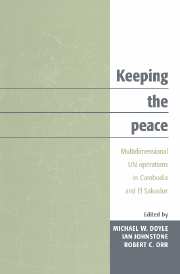Book contents
- Frontmatter
- Contents
- Preface
- Notes on the contributors
- List of abbreviations
- 1 Introduction
- Cambodia
- Map
- 2 Three visions of politics in Cambodia
- 3 The political dynamics of the peacemaking process in Cambodia
- 4 The Cambodian Settlement Agreements
- 5 Holding a fragile peace: the military and civilian components of UNTAC
- 6 Authority and elections in Cambodia
- 7 Returning home: the repatriation of Cambodian refugees
- 8 Quick impacts, slow rehabilitation in Cambodia
- El Salvador
- Conclusion and chronologies
- Select bibliography
- Index
7 - Returning home: the repatriation of Cambodian refugees
Published online by Cambridge University Press: 22 October 2009
- Frontmatter
- Contents
- Preface
- Notes on the contributors
- List of abbreviations
- 1 Introduction
- Cambodia
- Map
- 2 Three visions of politics in Cambodia
- 3 The political dynamics of the peacemaking process in Cambodia
- 4 The Cambodian Settlement Agreements
- 5 Holding a fragile peace: the military and civilian components of UNTAC
- 6 Authority and elections in Cambodia
- 7 Returning home: the repatriation of Cambodian refugees
- 8 Quick impacts, slow rehabilitation in Cambodia
- El Salvador
- Conclusion and chronologies
- Select bibliography
- Index
Summary
The peaceful and orderly return of the Cambodian refugees is both a clear expression of the confidence that the Cambodians have in the peace process and a decisive contribution to national reconciliation.
Yasushi Akashi, Special Representative of the Secretary-General in Cambodia, April 30, 1993.Introduction
Between March 30, 1992 and April 30, 1993 the United Nations High Commissioner for Refugees (UNHCR) facilitated the return of 361,462 refugees to their native land of Cambodia. While the logistical challenges involved in this exercise were imposing enough, the Repatriation Program for Cambodian Refugees aimed to be much more than a simple transport service. It endeavored to restore refugees – approximately 75 percent of whom were women and children – to their original homes, or somewhere else if they so chose, and provide the refugees with the raw materials with which to build a productive life: tools, land, building supplies for a new house, and food during a readjustment period.
In addition to affecting profoundly the futures of these 361,462 individuals, the UNHCR's program shouldered the burden of being one of three visible symbols of the success or failure of the United Nations' general program in Cambodia. At the time of the repatriation, the cantonment/disarmament of the factions' troops was already stalled in fundamental ways, and elections were not to come until later. The need for the UN repatriation program to be perceived as a success by the international community was therefore never far from the minds of the decision-makers.
- Type
- Chapter
- Information
- Keeping the PeaceMultidimensional UN Operations in Cambodia and El Salvador, pp. 165 - 185Publisher: Cambridge University PressPrint publication year: 1997
- 3
- Cited by



